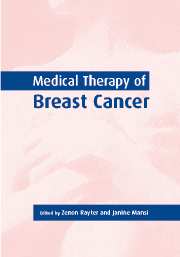Book contents
- Frontmatter
- Contents
- List of contributors
- 1 History of breast cancer therapy
- 2 Chemoprevention of breast cancer
- 3 Familial breast cancer
- 4 Hormone replacement therapy and breast cancer
- 5 Screening for breast cancer
- 6 The management of in situ breast cancer
- 7 Adjuvant systemic therapy
- 8 Adjuvant radiotherapy in the management of breast cancer
- 9 Predictors of response and resistance to medical therapy
- 10 Primary medical therapy in breast cancer
- 11 Medical therapy of advanced disease
- 12 Experimental approaches
- 12a High-dose chemotherapy in breast cancer
- 12b New immunological approaches to treatment for breast cancer
- 13 The place of bisphosphonates in the management of breast cancer
- 14 Palliative care in breast cancer
- Index
12a - High-dose chemotherapy in breast cancer
Published online by Cambridge University Press: 06 January 2010
- Frontmatter
- Contents
- List of contributors
- 1 History of breast cancer therapy
- 2 Chemoprevention of breast cancer
- 3 Familial breast cancer
- 4 Hormone replacement therapy and breast cancer
- 5 Screening for breast cancer
- 6 The management of in situ breast cancer
- 7 Adjuvant systemic therapy
- 8 Adjuvant radiotherapy in the management of breast cancer
- 9 Predictors of response and resistance to medical therapy
- 10 Primary medical therapy in breast cancer
- 11 Medical therapy of advanced disease
- 12 Experimental approaches
- 12a High-dose chemotherapy in breast cancer
- 12b New immunological approaches to treatment for breast cancer
- 13 The place of bisphosphonates in the management of breast cancer
- 14 Palliative care in breast cancer
- Index
Summary
Background: chemotherapy of breast cancer – theory and practice
Breast cancer is a partially chemotherapy sensitive neoplasm. Patients with metastases will usually achieve a degree of tumour response, with amelioration of the distressing symptoms of cancer, and some degree of survival prolongation. Some patients who are close to death, with impending failure of crucial organ systems, will be restored to reasonably good health, and will go on to live for months, or in some cases for years. Most responses are partial, however, and in all but exceptional cases, are temporary. Durable complete remission is only anecdotally reported (Cold et al., 1993; Greenberg et al., 1996).
Chemotherapy given as an adjuvant treatment to patients with earlier stage disease has a greater survival impact, and may contribute to cure (Early Breast Cancer Trialists’ Collaborative Group, 1992). This is consistent with the results of the classic experiments of Skipper and Schabel, which suggested that tumours grew exponentially with a constant growth rate, and that chemotherapy killed a constant proportion of cells. These investigators also found that there was an invariably inverse relationship between the size of a tumour and its curability by chemotherapy. Their model had profound implications for the concept of adjuvant systemic therapy, and appeared to be particularly relevant to breast cancer therapeutics (Skipper & Schabel, 1988). While several generations of studies have confirmed that adjuvant chemotherapy has a beneficial impact in patients with both node-positive and node-negative breast cancer, the impact is less than might have been expected on the basis of the Skipper–Schabel model (Norton & Simon, 1986).
- Type
- Chapter
- Information
- Medical Therapy of Breast Cancer , pp. 310 - 328Publisher: Cambridge University PressPrint publication year: 2003



